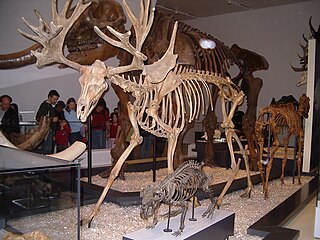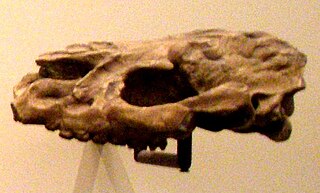 W
WCadurcodon is an extinct genus of amynodont rhino that lived during the Late Eocene to the Oligocene period. Fossils have been found throughout Mongolia and China. It may have sported a tapir-like proboscis due to the distinct features found in fossil skulls.
 W
WCervalces is an extinct deer genus that lived during the Pliocene and Pleistocene epochs. Cervalces gallicus, the ancestral species, lived in Europe from the Pliocene to the Pleistocene strata. Cervalces scotti, the stag-moose, lived in Pleistocene North America. Cervalces latifrons, the broad-fronted moose, and Cervalces carnutorum were found in Pleistocene Europe and Asia.
 W
WCreodonta is an extinct, possibly polyphyletic order of carnivorous mammals that lived from the Paleocene to the Miocene epochs. Because they both possess carnassial teeth, creodonts and carnivorans were once thought to have shared a common ancestor, but given that different teeth are involved in making up the carnassials, this appears to be a case of evolutionary convergence. Carnassials are also known in other mammal clades, such as in the extinct bat Necromantis.
 W
WDarwinius is a genus within the infraorder Adapiformes, a group of basal strepsirrhine primates from the middle Eocene epoch. Its only known species, Darwinius masillae, lived approximately 47 million years ago based on dating of the fossil site.
 W
WDiceratherium is an extinct genus of rhinoceros endemic to North America, Europe, and Asia during the Oligocene through Miocene living from 33.9—11.6 mya, existing for approximately 22.3 million years . Mass estimates for the type species, D. armatum average around 1 t (2,200 lb)
 W
WDorcatherium is an extinct genus of tragulid ruminant which existed in Europe, East Africa and the Siwaliks during the Miocene and Pliocene.
 W
WEomanis is the earliest known true pangolin from extinct family Eomanidae within suborder Eupholidota. It lived during the Eocene in Europe. Eomanis fossils found in the Messel Pit in Germany are very similar in size and anatomy to living pangolins of the genus Manis, indicating that pangolins have remained largely unchanged in morphology and behavior for 50 million years. However, unlike modern pangolins, its tail and legs did not bear scales. According to the stomach contents of the excellently preserved Messel specimens, Eomanis’ diet consisted of both insects and plants.
 W
WEucladoceros or bush-antlered deer is an extinct genus of deer whose fossils have been discovered in Europe, the Middle East and Central Asia. This genus was formally described by Hugh Falconer in 1868.
 W
WEuromanis is the earliest known pangolin. It lived during the Eocene in Europe. Euromanis fossils found in the Messel Pit in Germany. Unlike modern pangolins, it did not bear scales on it's body.
 W
WHipparion is an extinct genus of horse that lived in North America, Asia, Europe, and Africa during the Miocene through Pleistocene ~23 Mya—781,000 years ago. It lived in non-forested, grassy plains, shortgrass prairie or steppes.
 W
WHomotherium is an extinct genus of machairodontine saber-toothed cats, often termed scimitar-toothed cats, that inhabited North America, South America, Eurasia, and Africa during the Pliocene and Pleistocene epochs, existing for approximately 4 million years.
 W
WHyaenodon ("hyena-tooth") is the type genus of the Hyaenodontidae, a family of extinct carnivorous fossil mammals from Eurasia, North America, and Africa, with species existing temporally from the Eocene until the middle Miocene, existing for about 26.1 million years .
 W
WA mammoth is any species of the extinct elephantid genus Mammuthus, one of the many genera that make up the order of trunked mammals called proboscideans. The various species of mammoth were commonly equipped with long, curved tusks and, in northern species, a covering of long hair. They lived from the Pliocene epoch into the Holocene at about 4,000 years ago, and various species existed in Africa, Europe, Asia, and North America. They were members of the family Elephantidae, which also contains the two genera of modern elephants and their ancestors.
 W
WMegantereon was a genus of prehistoric machairodontine saber-toothed cat that lived in North America, Eurasia, and Africa. It may have been the ancestor of Smilodon.
 W
WMetailurus is a genus of saber-toothed cat in the family Felidae, and belonging to the tribe Metailurini, which occurred in North America, Eurasia and Africa from the Miocene to the Middle Pleistocene. This genus was formally described by O. Zdansky in 1924. Metailurus minor has been reassigned to the felid genus Yoshi.
 W
WPachycrocuta was a genus of prehistoric hyenas. The largest and most well-researched species is Pachycrocuta brevirostris, colloquially known as the giant short-faced hyena as it stood about 90–100 cm (35–39 in) at the shoulder and it is estimated to have averaged 110 kg (240 lb) in weight, approaching the size of a lioness, making it the largest known hyena. Pachycrocuta first appeared during the late Miocene and became extinct during the middle Pleistocene, 400,000 years ago.
 W
WParacamelus is an extinct genus of camel in the family Camelidae. It originated in North America during the Middle Miocene but crossed the Beringian land bridge into Eurasia during the Late Miocene, approximately 7.5–6.5 Ma; its later range spanned from Spain and Italy to Chad and Shanxi Province, China. It is ancestral to living camels of the genus Camelus. A population remained in northern North America, which became the high Arctic camel, which survived until the Middle Pleistocene approximately 1 Ma.
 W
WParamys is an extinct genus of rodents from North America, Europe, and Asia. It is one of the oldest genera of rodents known and probably lived in trees. While the genus name literally means "like a mouse", it coexisted with Thisbemys, a similar rodent, thus yielding a reference to Pyramus and Thisbe.
 W
WPlioviverrops is an extinct genus of terrestrial carnivore of the family Hyaenidae, endemic to Southern Europe during the Late Miocene subepoch existing for approximately 6.3 million years . It was named by Kretzoi in 1938, and assigned to Hyaenidae by Flynn in 1998.
 W
WProboscidipparion is an extinct genus of horse that lived in Eurasia during the Pliocene around 7.1 - 4 million years ago. It is known for having a rather elongated skull, in which some speculate to have had a proboscis similar to a tapir. Fossils have been found throughout Eurasia, from England to China.
 W
WProtapirus is an extinct genus of tapir. Fossil specimens of this genus have been found in North America and Europe.
 W
WTeilhardina was an early marmoset-like primate that lived in Europe, North America and Asia during the Early Eocene epoch, about 56-47 million years ago. The paleontologist George Gaylord Simpson is credited with naming it after the French paleontologist, Jesuit and philosopher Teilhard de Chardin.
 W
WVeratalpa lugdunensiana is a fossil mammal from the Miocene of France. Known from a single astragalus, the species was assigned to its own genus, Veratalpa, by Florentino Ameghino in 1905. He placed it in Talpidae, the family of the moles, but in 1974, John Howard Hutchison argued that the astragalus was not talpid and more likely came from a rodent. The astragalus is about 4.5 mm long, broad for a talpid, and has the head oriented farther from the axis of the foot than in talpids.